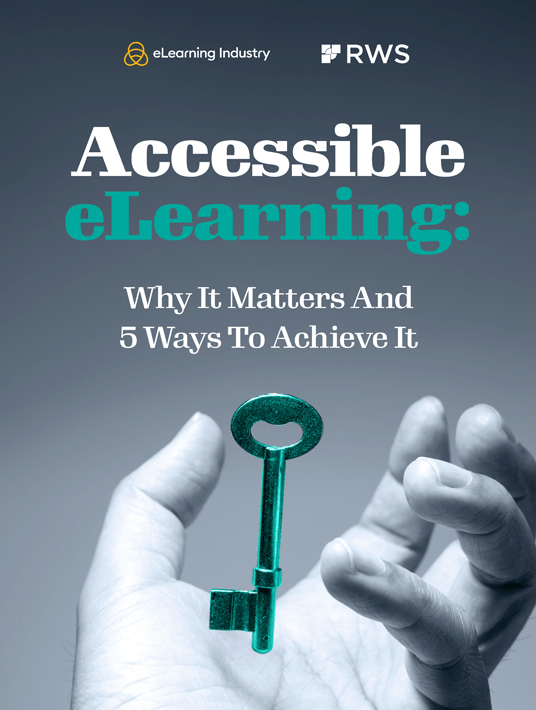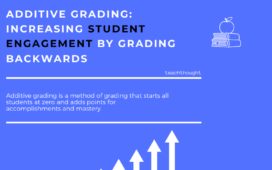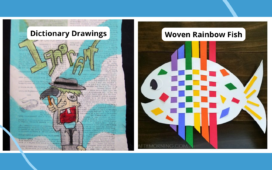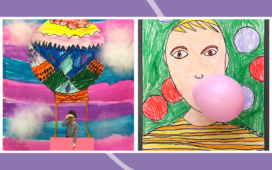How Can Learning Content Be More Accessible To Learners With Hearing Impairments?
According to a report by the World Health Organization, almost 5% of the global population—over 400 million people—experience a level of hearing loss that requires rehabilitation. Projections indicate that this number will rise to at least 700 million by the year 2050. These numbers make it clear that individuals with disabilities, specifically those with hearing impairments, form a significant part of our society and should be able to participate equally. Research has shown that deaf people are more likely to find employment when they have a higher education level. However, this requires access to inclusive content designed to adapt to their needs, which is often not the case. In this article, we will explore the challenges that learners with hearing impairments face on a regular basis and provide tips for designing learning content with accessibility in mind.

eBook Release
Accessible eLearning: Why It Matters And 5 Ways To Achieve It
Discover how to create accessible eLearning experiences that are meaningful for everyone and how to overcome some of the obstacles that learners face.
Challenges Individuals With Hearing Disabilities Face
Lack Of Accessible Content
Learners with hearing impairments often enroll in learning courses—either online or offline—only to realize that there is a significant lack of inclusive materials. Either the course relies heavily on visual materials such as videos without any captioning or transcriptions, or it promotes audio-only formats, most commonly podcasts. Overlooking to incorporate the right accessibility tools into your training course can isolate learners with disabilities and ultimately exclude them from your learning community.
Inadequate Captioning And Transcription
In some cases, eLearning developers do include accessibility tools in training courses, most frequently captions and transcriptions. However, if these features are not regularly checked and updated, they can end up causing more harm than good for learners. Some examples of inadequate captioning include subtitles that are missing, incorrect, or poorly timed. Errors and inaccuracies are especially common with automated captioning. Transcription tools, which are often used in live sessions or webinars, may lag or fail to accurately capture what is being said, thus impeding learner comprehension.
Communication Barriers During Live Sessions
Perhaps the hardest part of learning for individuals with hearing impairments is participating in live sessions. When discussions, questions, and debates happen in real-time, it is exceptionally difficult for accessibility tools to keep disabled learners in the loop, assuming that they have access to such tools in the first place. While transcription tools and real-time captioning are often available, sign language interpreters are rare in educational settings. As a result, learners with disabilities struggle to follow the pace of the session, often missing significant information and feeling left behind.
Interactive Elements
Nowadays, learning courses offer learners a multitude of interactive experiences to increase their engagement, such as group discussions, oral presentations, breakout rooms, and Q&A sessions. But how can hard of hearing individuals take advantage of these opportunities if participating in them depends primarily on responding to auditory cues from instructors and peers? Unfortunately, the answer is that, more often than not, they can’t. Given the limited accessibility tools they have at their disposal, it is particularly challenging for them to follow real-time oral conversations and engage effectively in these interactive and collaborative activities.
Technical Issues
Digital learning environments may pose several challenges to learners with disabilities as their assistive technologies may not be supported. For example, if a learning platform doesn’t offer a captioning feature and also isn’t compatible with speech-to-text tools, it can be particularly challenging—in fact, almost impossible—for learners to communicate with their instructors and peers. At the same time, technical issues such as poor sound quality, background noise, or inadequate volume control options may further prevent learners from accessing the learning material.
Social Interactions And Engagement
Socializing is a primary challenge for learners with hearing impairments, both inside and outside of the classroom. Lack of awareness from other participants, combined with limited compatibility with assistive technology, often leaves learners with disabilities unable to participate in informal discussions, networking events, and even group projects that may carry significance for their grades and learning progress. In time, the inability to participate effectively in the learning environment will impact their sense of belonging and lead to frustration and disengagement.
6 Tips To Design Inclusive Learning For Learners With Hearing Impairments
1. High-Quality Captions And Transcriptions
When designing inclusive training courses for diverse audiences, particularly those with hearing impairments, high-quality captions and transcriptions are essential. You must add these tools not just to adhere to accessibility guidelines but to sincerely welcome and support all learners. To ensure the accuracy of captions and transcriptions, opt for a human editor and don’t rely solely on automation. When that is not possible, i.e., during live sessions, use reliable real-time transcription services that instantly convert spoken word into text. Remember to regularly review your captions and transcription tools, especially if you have made any changes to the learning material.
2. Enhanced Visual And Textual Alternatives
Learners with hearing disabilities are likely to find slides, written guides, and summaries particularly helpful. These resources must be well-organized and written in an eligible font and size. Moreover, don’t forget to upload them well in advance so that learners have time to review them before class. However, keep in mind that if all learning material is presented in text form, learner engagement will be impacted. To retain learner attention and help them better understand the subject at hand, you must leverage visual aids such as slides, infographics, and diagrams. Accompany them with adequate written explanations so that learners can understand them with limited verbal support.
3. Accessible Communication Tools
We have already mentioned captions and real-time transcriptions, but there are many more communication tools you can use to make the learning environment more inclusive. Something that is not that common in learning but deserves more attention is sign language interpreters. They can be useful in synchronous as well as asynchronous learning sessions, appearing on the screen at all times. Moreover, it is important to provide text communication channels, such as chat boxes and forums, where learners can ask questions and receive immediate feedback. Finally, ensure that any learning or web conferencing platforms you use support all of these accessibility features.
4. Interactive Elements
When discussing the challenges that learners with hearing impairments face, we mentioned how hard it is for them to participate in interactive activities. Rather than excluding them or limiting everything to text-based projects, consider how you can make interactions more accessible. For example, if you are running a live quiz, enable chat responses that display the results visually. Provide pre-prepared written instructions for any group activity. By combining these with immediate response chat boxes, disabled learners will never feel lost again during class. Most importantly, allow learners to choose how they want to communicate. Do they prefer a chat option or a text-to-speech tool? By supporting many communication methods, you facilitate collaboration for learners and make them feel at ease in the learning environment.
5. Inclusive Interface And Content Design
The way that you design the user interface of your learning program can make a huge difference in its inclusivity. You must develop a clean and minimalistic layout that makes it easy for learners to find the information they need. Navigation will be further enhanced if it is consistent throughout the duration of the course with visible action buttons. Moreover, use readable fonts with colors that enhance readability without overwhelming the slides. Incorporate visual cues, such as infographics and visual summaries, to enhance comprehension and provide access to adequate audio settings that will help students overcome background noise and low-volume speech. Finally, make sure the content is available in various formats with visual aids and explanations where necessary.
6. Providing Support And Resources
Just as the rest of your learners, individuals with hearing impairments will require support at various points of their learning journey. Initially, they might need an introduction to the accessibility features of your course so that they can use them as best as possible. Moreover, they might need technical assistance when their assistive devices are not connecting correctly to the learning platform. For learners to be able to express their concerns and connect with peers, instructors, or course coordinators with ease, make sure to provide them with different communication channels, like email, forums, and direct chat. This way, you will be able to quickly identify accessibility issues you need to address and gather feedback on resources that learners may find useful.
Conclusion
Despite popular belief, making learning programs accessible is not impossible. In fact, it is a necessity for the future of eLearning, which becomes increasingly easier to implement as technology advances. The numerous challenges that learners with hearing impairments face today can be overcome if instructors take the time to identify the best ways to promote inclusive learning. By implementing the tips we discussed in this article, you will be able to help learners with disabilities feel supported throughout their learning journey, thus enhancing their confidence, engagement, and, ultimately, their learning outcomes.
Download Accessible eLearning: Why It Matters And 5 Ways To Achieve It today to uncover more tips on how to address accessibility and ensure that all learners can fully engage with the material and participate in the learning process.















